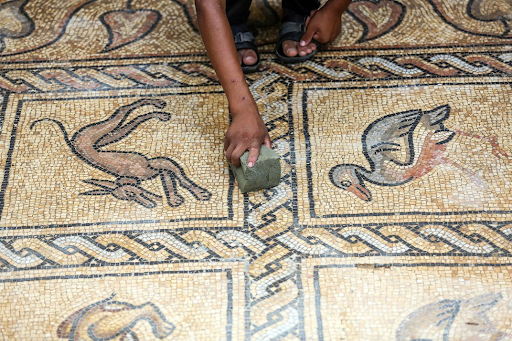Image source Smithsonian
Some days, it can be hard to be a farmer. Such was the case for Palestinian olive grower, Salman al-Nabahin. Earlier this year, he was perplexed about why some trees weren't flourishing in a particular area. The reason, he soon discovered, was a huge surprise. Working with his son to investigate below the surface, they were shocked when a hard surface and animal figures appeared.

Image source BBC
"I searched on the internet - We learned it was a mosaic belonging to the Byzantine era," said the father-of-seven, shown above. "I see it as a treasure, dearer than a treasure. It isn't personal, it belongs to every Palestinian."

Image source Times Of Israel
It is indeed a treasure. Scholars say that the mosaic floor dates back to a time between the 5th and the 7th centuries. A more proper excavation must be conducted to determine when exactly it was built and whether it was part of a religious or secular complex.
The Palestinian Ministry of Tourism and Antiquities says the flooring includes several mosaic panels depicting animals and other features of social life during the Byzantine era. The Byzantine Empire lasted from around the split of the Roman Empire into Eastern and Western Empires in 395 until its conquest by the Ottoman Turks in 1453.

Image source CNN
It’s also endangered. The location, inside the Bureij refugee camp, is about half a mile from the border with Israel. The Gaza Strip, a Palestinian coastal enclave sandwiched between Israel and Egypt, was once a busy trade route in history. The coastal strip is full of artifacts from ancient civilizations, from the Bronze Age to the Islamic and Ottoman eras.
Sadly, archaeological finds have not always been accorded the respect they deserve throughout history. Looting and destruction from building projects have taken their toll. Several discoveries have been made in Gaza in recent years - but the international community has helped. Due to a lack of funds and expertise, Gaza has usually invited groups from other countries to help with the process of excavation and preservation.
“The archaeological discovery is still in its early stages and we await to know more of the secrets and civilisation values,” the Palestinian ministry of tourism and antiquities said in a statement. “National research teams are working in partnership with international experts and scientists from the French Biblical and Archaeological School of Jerusalem.”

Image source The Guardian
Those experts are thrilled about the major find, which appears to measure about 250 square feet in size. The largest of the holes in the ground, about 6 feet by 9 feet, has the 17 drawings of animals. The other two show intricate patterns of tiles.

Image source The Guardian
“These are the most beautiful mosaic floors discovered in Gaza, both in terms of the quality of the graphic representation and the complexity of the geometry,” comments René Elter, an archaeologist at the French Biblical and Archaeological School of Jerusalem. “Never have mosaic floors of this finesse, this precision in the graphics and richness of the colors been discovered in the Gaza Strip.”

Image source BBC
However, Elter warns, the discovery is in “immediate danger” because of it’s closeness to the Israeli separation fence. “It is imperative to quickly organize an emergency rescue intervention,” he says.

Image source BBC
Such areas along the fence are often the scene of intermittent clashes or Israeli incursions. Elter also worries that excavations by inexperienced people could damage the site. His hope is a professional team can properly excavate, restore and protect the mosaic.
Keep up with the latest mosaic news by subscribing to our newsletter! We cover a wide range of topics, with new articles weekly.

